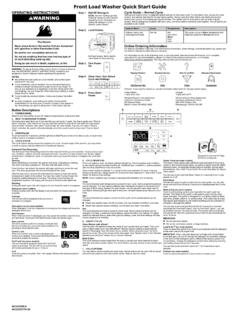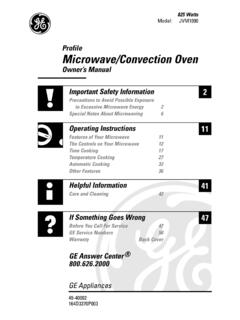Transcription of THE ULTIMATE FAST FACTS GUIDE TO NUCLEAR ENERGY
1 NUCLEAR ENERGYTHE ULTIMATE FAST FACTS GUIDE TONuclear ENERGY has been quietly powering America with clean, carbon-free electricity for the last 60 years. It may not be the first thing you think of when you heat or cool your home, but maybe that s the point. It s been so reliable that we sometimes take it for granted. Did you know about a fifth of the country s electricity comes from NUCLEAR power each year? If not, then it s about time you get to know NUCLEAR . Here are five fast FACTS to get you up to speed:1. NUCLEAR POWER PLANTS PRODUCED 805 BILLION KILOWATT HOURS OF ELECTRICITY IN 2017 The United States is the world s largest producer of NUCLEAR power.
2 It generated just under 805 billion kilowatt hours of electricity in 2017 enough to power 73 million homes. Commercial NUCLEAR power plants have supplied around 20% of the nation s electricity each year since NUCLEAR POWER PROVIDES 56% OF AMERICA S CLEAN ENERGYN uclear ENERGY provided 56% of America s carbon-free electricity in 2017, making it by far the largest domestic source of clean ENERGY . NUCLEAR power plants do not emit greenhouse gases while generating electricity. They produce power by boiling water to create steam that spins a turbine.
3 The water is heated by a process called fission, which makes heat by splitting apart uranium atoms inside a NUCLEAR reactor core. 3. NUCLEAR ENERGY IS THE MOST RELIABLE ENERGY SOURCE IN AMERICAN uclear power plants operated at full capacity more than 92% of the time in 2017 making it the most reliable ENERGY source in America. That s nearly twice as reliable as coal (54%) and natural gas (55%) plants, and 2 to 3 times more reliable than wind (37%) and solar (27%) plants. NUCLEAR power plants are designed to run 24 hours a day, 7 days a week because they require less maintenance and can operate for longer stretches before refueling (typically every or 2 years).
4 4. NUCLEAR HELPS POWER 30 STATESAs of September 2018, 98 commercial reactors help power homes and businesses in 30 states. Illinois has 11 reactors the most of any state and joins South Carolina and New Hampshire in receiving more than 50% of its power from NUCLEAR . 5. NUCLEAR FUEL IS EXTREMELY DENSEB ecause of this, the amount of used NUCLEAR fuel is not as big as you think. All of the used NUCLEAR fuel produced by the NUCLEAR ENERGY industry over the last 60 years could fit on a football field at a depth of less than 10 UP!
5 MAGAZINE GENERAL INFO5 FAST FACTS ABOUT NUCLEAR ENERGY Source: ENERGY Information AdministrationAMPED UP! MAGAZINE HOW IT WORKSHOW DOES A NUCLEAR REACTOR WORK? 431 utility-scale wind million PV panels45 NUCLEAR REACTORS ARE THE HEART OF A NUCLEAR POWER PLANT. They contain and control NUCLEAR chain reactions that produce heat through a physical process called fission. That heat is used to make steam that spins a turbine to create more than 450 commercial reactors worldwide, including 98 in the United States, NUCLEAR power continues to be one of the largest sources of reliable carbon-free electricity FISSION CREATES HEATThe main job of a reactor is to house and control NUCLEAR fission a process where atoms split and release ENERGY .
6 Reactors use uranium for NUCLEAR fuel. The uranium is processed into small ceramic pellets and stacked together into sealed metal tubes called fuel rods. Typically, more than 200 of these rods are bundled together to form a fuel assembly. A reactor core is usually made up of a couple hundred assemblies, depending on the power level. Inside the reactor vessel, the fuel rods are immersed in water , which acts as both a coolant and moderator. The moderator helps slow down the neutrons produced by fission to sustain the chain rods can then be inserted into the reactor core to reduce the reaction rate or withdrawn to increase heat created by fission turns the water into steam , which spins a turbine to produce carbon-free OF LIGHT- water REACTORS IN THE UNITED STATES All commercial NUCLEAR reactors in the United States are light- water reactors.
7 This means they use normal water as both a coolant and neutron are two types of light- water reactors operating in America:PRESSURIZED- water NUCLEAR REACTORSMore than 65% of the commercial reactors in the United States are pressurized- water reactors or PWRs. These reactors pump water into the reactor core under high pressure to prevent the water from boiling. The water in the core is heated by NUCLEAR fission and then pumped into tubes inside a heat exchanger. Those tubes heat a separate water source to create steam . The steam then turns an electric generator to produce electricity.
8 The core water cycles back to the reactor to be reheated and the process is water REACTORSR oughly a third of the reactors operating in the United States are boiling water reactors (BWRs).BWRs heat water and produce steam directly inside the reactor vessel. water is pumped up through the reactor core and heated by fission. Pipes then feed the steam directly to a turbine to produce electricity. The unused steam is then condensed back to water and reused in the heating process. 100 million LED bulbsHOW MUCH POWER DOES A NUCLEAR REACTOR PRODUCE?
9 A typical reactor produces around 1 gigawatt of power or the same amount of power as:To better understand what makes NUCLEAR so reliable, take a look at the graph you can see, NUCLEAR ENERGY has, by far, the highest capacity factor of any other ENERGY source. This basically means NUCLEAR power plants are producing maximum power more than 92% of the time during the s almost twice as reliable as coal or natural gas units, and 2 to 3 times more reliable than wind and solar ARE NUCLEAR POWER PLANTS MORE RELIABLE? NUCLEAR power plants are typically used more often because they require less maintenance and are designed to operate for longer stretches before refueling (typically every or 2 years).
10 Natural gas and coal capacity factors are generally lower due to routine maintenance and/or refueling at these plants are considered intermittent or variable sources and are mostly limited by a lack of fuel ( wind, sun, or water ). As a result, these plants need a backup power source such as large-scale storage (not currently available at grid-scale) or they can be paired with a reliable baseload power like NUCLEAR DOES THIS MATTER?A typical NUCLEAR reactor produces 1 gigawatt (GW) of electricity. That doesn t mean you can simply replace it with a 1 gigawatt coal or renewable on the capacity factors above, you would need almost two coal or nearly three renewable plants (each of 1 GW size) to generate the same amount of electricity onto the POWER IS THE MOST RELIABLE ENERGY SOURCE AND IT S NOT EVEN CLOSES ource: ENERGY Information Administration76 AMPED UP!
















